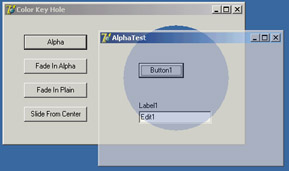Unusual Techniques: Alpha Blending, Color Key,and the Animate API
Unusual Techniques: Alpha Blending, Color Key,and the Animate API
One of the recent Delphi features related to forms is support for new Windows APIs that affect the way forms are displayed (in Windows 2000/XP, but not available under Qt/CLX). Alpha blending allows you to merge the content of a form with what's behind it on the screen—functionality you'll rarely need, at least in a business application. The technique is more interesting when applied to bitmap (with the new AlphaBlend and AlphaDIBBlend API functions) than to a form. In any case, by setting the AlphaBlend property of a form to True and giving to the AlphaBlendValue property a value lower than 255, you'll be able to see in transparency what's behind the form. The lower the AlphaBlendValue, the more the form will fade. You can see an example of alpha blending in Figure 7.7, taken from the ColorKeyHole example.

Figure 7.7: The output of the ColorKeyHole, showing the effect of the new TransparentColor and AlphaBlend properties and the Animate-Window API
Another unusual Delphi feature is the TransparentColor boolean property, which allows you to indicate a transparent color that will be replaced by the background, creating a sort of hole in a form. The actual transparent color is indicated by the TransparentColorValue property. Again, you can see an example of this effect in Figure 7.7.
Finally, you can use a native Windows technique, animated display, which is not directly supported by Delphi (beyond the display of hints). For example, instead of calling the Show method of a form, you can write
Form3.Hide; AnimateWindow (Form3.Handle, 2000, AW_BLEND); Form3.Show;
Notice you have to call the Show method at the end for the form to behave properly. You can also obtain a similar animation effect by changing the AlphaBlendValue property in a loop. The AnimateWindow API can also be used to control how the form is brought into view, starting from the center (with the AW_CENTER flag) or from one of its sides (AW_HOR_POSITIVE, AW_HOR_NEGATIVE, AW_VER_POSITIVE, or AW_VER_NEGATIVE), as is common for slide shows.
You can apply this same function to windowed controls, obtaining a fade-in effect instead of the usual direct appearance. I have serious doubts about the waste of CPU cycles these animations cause, but I must say that if they are applied properly and in the right program, they can improve the user interface.








